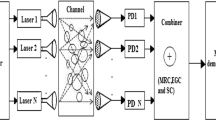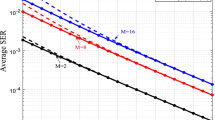Abstract
In this article, we analyze the bit error rate (BER) performance of the multiple-input multiple-output (MIMO) based free-space optical (FSO) link by adopting Gamma–Gamma (GG) distribution with atmospheric turbulences (ATs) and pointing errors (PEs). By expanding the GG distribution, the complexity is high due to Meijer-G function with MIMO. To reduce the complexity, we proposed a mathematically tractable power series based probability density function of the GG fading with PEs and ATs. Based on the proposed power series PDF, the exact BER is derived, allowing to analyze the BER performance for single-input single-output (SISO), Single Input Multiple Output (SIMO) and extended to MIMO link for three combining schemes with M-ary Phase Shift Keying (M-PSK). The derived BER expression also helps to derive the Asymptotic Bit Error Rate (ABER), diversity gain, combining gain and cross-validated for SISO, SIMO and MIMO/FSO links. The effect of PEs over the performance of the FSO link is analyzed and observed that PEs degrades the BER and gain of the FSO link rapidly. The deduced MRC provides high SNR gain at-least 3.5 dB over EGC and 8 dB gain over SC for negligible PEs ξ = 11.23 at BER 10−6 and for BER 10−3, the SNR gain for MRC over EGC is 1.5 dB and approximately above 3 dB over SC for severe PEs ξ = 1.23. The proposed power series based PDF offers high gain and power efficiency of the MIMO/FSO link over SISO and SIMO link. This article identifies the crucial factors affecting the FSO link and helps in mitigating them to design an optimal system and opens for wide range of applications like fifth-generation (5G) networks, smart city applications etc.















Similar content being viewed by others
References
Abadi, M.M., Ghassemlooy, Z., Khalighi, M.-A., Zvanovec, S., Bhatnagar, M.R.: FSO detection using differential signaling in outdoor correlated-channels condition. IEEE Photon. Technol. Lett. 28(1), 55–58 (2016)
Abou-Rjeily, C.: On the optimality of the selection transmit diversity for MIMO-FSO links with feedback. IEEE Commun. Lett. 15(6), 641–643 (2011)
Ahdi, F., Subramaniam, S.: Optimal placement of FSO relays for network disaster recovery. In: Proc. IEEE Int. Conf. Commun., Budapest, Hungary, pp. 3921–3926 (2013)
Alamouti, S.M.: A simple transmit diversity technique for wireless communications. IEEE J. Sel. Areas Commun. 16(8), 1451–1458 (1998)
Anguita, J.A., Djordjevic, I.B., Neifeld, M.A., Vasic, B.V.: Shannon capacities and error-correction codes for optical atmospheric turbulent channels. J. Opt. Netw. 4(9), 586–601 (2005)
Bayaki, E., Schober, R., Mallik, R.K.: Performance analysis of MIMO free-space optical systems in gamma-gamma fading. IEEE Trans. Commun. 57(11), 3415–3424 (2009)
Bhatnagar, M.R.: Differential decoding of SIM DPSK over FSO MIMO links. IEEE Commun. Lett. 17(1), 79–82 (2013)
Bhatnagar, M.R.: A one bit feedback based beamforming scheme for FSO MISO system over gamma–gamma fading. IEEE Trans. Commun. 63(4), 1306–1318 (2015)
Bhatnagar, M.R., Ghassemlooy, Z.: Performance evaluation of FSO MIMO links in gamma-gamma fading with pointing error. In: Proc. IEEE Int. Conf. Commun., London, UK, pp. 1–6 (2015)
Farid, A.A., Hranilovic, S.: Outage capacity optimization forfree-space optical links with pointing errors. IEEE/OSA J. Lightw. Technol. 25(7), 1702–1710 (2007)
Gappmair, W.: Further results on the capacity of free-space optical channels in turbulent atmosphere. IET Commun. 5(9), 1262–1267 (2011)
Gradshteyn, S., Ryzhik, I.M.: Table of Integrals, Series, and Products, 6th edn. Academic, San Diego (2000)
Jaiswal, I., Sangeetha, R.G., Suchetha, M.: Performance of M-ary quadrature amplitude modulation-based orthogonal frequency division multiplexing for free space optical transmission. IET Optoelectron. 10, 156–162 (2016)
Kedar, D., Arnon, S.: Urban optical wireless communication networks: the main challenges and possible solutions. IEEE Commun. Mag. 42(5), S2–S7 (2004)
Lee, I.E., Ghassemlooy, Z., Ng, W.P., Khalighi, M.-A.: Joint optimization of a partially coherent Gaussian beam for free-space optical communication over turbulent channels with pointing errors. Opt. Lett. 38(3), 350–352 (2013)
Letzepis, N., Fabregas, A.G.: Outage probability of the Gaussian MIMO free-space optical channel with PPM. IEEE Trans. Commun. 57(12), 3682–3690 (2009)
Liu, X.: Free-space optics optimization models for building sway and atmospheric interference using variable wavelength. IEEE Trans. Commun. 57(2), 492–498 (2009)
Lu, J., Letaief, K.B., Chuang, J.C.-I., Liou, M.L.: M-PSK and M-QAM BER computation using signal-space concepts. IEEE Trans. Commun. 47(2), 181–184 (1999)
Nistazakis, H.E., Karagianni, E.A., Tsigopoulos, A.D., Fafalios, M.E., Tombras, G.S.: Average capacity of optical wireless communication systems over atmospheric turbulence channels. IEEE/OSA J. Lightw. Technol. 27(4), 974–979 (2009a)
Nistazakis, H.E., Tsiftsis, T.A., Tombras, G.S.: Performance analysis of free-space optical communication systems over atmospheric turbulence channels. IET Commun. 3(8), 1402–1409 (2009b)
Park, J., Lee, E., Yoon, G.: Average bit-error rate of the Alamouti scheme in gamma–gamma fading channels. IEEE Photon. Technol. Lett. 23(4), 269–271 (2011)
Peppas, K.P., Datsikas, C.K.: Average symbol error probability of general-order rectangular quadrature amplitude modulation of optical wireless communication systems over atmospheric turbulence channels. J. Opt. Commun. Netw. 2(2), 102–110 (2010)
Popoola, W.O., Ghassemlooy, Z.: BPSK subcarrier intensity modulated free-space optical communications in atmospheric turbulence. J. Lightw. Technol. 27(8), 967–973 (2009)
Popoola, W., Ghassemlooy, Z., Allen, J., Leitgeb, E., Gao, S.: Free-space optical communication employing subcarrier modulation and spatial diversity in atmospheric turbulence channel. IET Opt. 2(1), 16–23 (2008a)
Popoola, W., Ghassemly, Z., Leitgeb, E.: BER performance of DPSK subcarrier modulated free space optics in fully developed speckle. In: International Symposium on Communication Systems, Networks and Digital Siganl Processing, pp. 273–277 (2008)
Roach, K.: Meijer-G function representations. In: Proc. ACM Int. Conf. Symbolic Algebraic Comput., pp. 205–211 (1997)
Sandalidis, H.G., Tsiftsis, T.A.: Outage probability and ergodic capacity of free-space optical links over strong turbulence. Electron. Lett. 44(1), 46–47 (2008)
Sandalidis, H.G., Tsiftsis, T.A., Karagiannidis, G.K., Uysal, M.: BER performance of FSO links over strong atmospheric turbulence channels with pointing errors. IEEE Commun. Lett. 12(1), 44–46 (2008)
Song, X., Cheng, J.: Subcarrier intensity modulated MIMO optical communications in atmospheric turbulence. IEEE/OSA J. Opt. Commun. Netw. 5(9), 1001–1009 (2013)
Tsiftsis, T.A., Sandalidis, H.G., Karagiannidis, G.K., Uysal, M.: Optical wireless links with spatial diversity over strong atmospheric turbulence channels. IEEE Trans. Wirel. Commun. 8(2), 951–957 (2009)
Uysal, M., Li, J., Yu, M.: Error rate performance analysis of coded free-space optical links over gamma–gamma atmospheric turbulence channels. IEEE Trans. Wirel. Commun. 5(6), 1229–1233 (2006a)
Uysal, M., Li, J., Yu, M.: Error rate performance analysis of coded free-space optical links over gamma–gamma atmospheric turbulence channels. IEEE Trans. Wirel. Commun. 5(6), 1229–1233 (2006b)
Wang, Z., Zong, W.D., Fu, S., Lin, C.: Performance comparison of different modulation formats over free-space optical (FSO0) turbulence links with space diversity reception techniques. IEEE Photon. 1(6), 277–285 (2009)
Yang, G., Khalighi, M.K., Ghassemlooy, Z., Bourennane, S.: Performance evaluation of receive-diversity free-space optical communications over correlated gamma–gamma fading channels. OSA Appl. Opt. 52(24), 5903–5911 (2013)
Zhou, H., Xie, W., Zhang, L., Bai, Y., Wei, W., Dong, Y.: Performance analysis of FSO coherent BPSK systems over Rician turbulence channel with pointing errors. Opt. Express 27, 27062–27075 (2019)
Author information
Authors and Affiliations
Corresponding author
Additional information
Publisher's Note
Springer Nature remains neutral with regard to jurisdictional claims in published maps and institutional affiliations.
Rights and permissions
About this article
Cite this article
Anand Kumar, D., Sangeetha, R.G. Power series based gamma–gamma fading MIMO/FSO link analysis with atmospheric turbulence and pointing errors. Opt Quant Electron 53, 505 (2021). https://doi.org/10.1007/s11082-021-03103-7
Received:
Accepted:
Published:
DOI: https://doi.org/10.1007/s11082-021-03103-7




